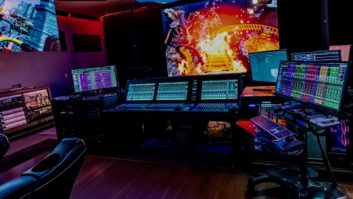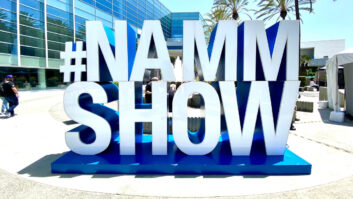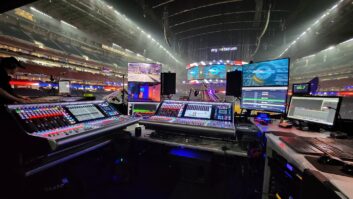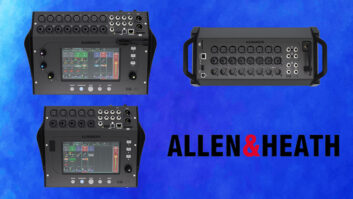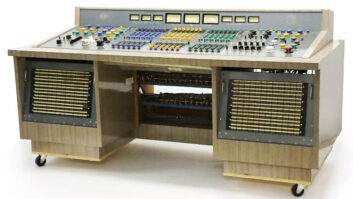Previewed in closed-door, behind-the-scenes peaks at last week’s NSCA show in Las Vegas, Soundcraft’s long-awaited, first large-format digital live desk has arrived and I was among the first to check it out. The new Soundcraft Vi6 was designed using the proven reliability of Studer’s Vista and On-Air 3000 consoles series and uses a derivation of the Vistonics user interface (Vistonics II) for fast, intuitive operation. The Vi6 employs the same type of touch-screen color TFT monitor with integral rotary controls and switches mounted on the glass, providing the “where-you-look-is where-you-control” interface that made Studer’s Vista series so popular with users.
Senior product manager Andy Brown was charged with harnessing the collaborative power of Soundcraft and Studer to deliver the new console design. With Soundcraft’s sister company Studer well into its second generation of digital audio mixing products, Brown had access to substantial software and hardware that was already proven in the workplace. Studer’s strengths lay mainly in the broadcast market, yet Brown and his team were able to embark on a knowledge exchange that combined choice elements of Studer design with Soundcraft’s experience of building live sound mixing consoles.
“Originally, we had hoped to modify existing Studer products, but we soon switched to a different approach,” Brown says. “We’ve taken the best elements from Studer’s Vista series, combined these with the latest thinking in software and user interfaces and presented them in an easy-to-use, roadworthy package that can be successfully, repeatedly and reliably manufactured at an affordable price.”
Brown and Soundcraft founder Graham Blyth (now the company’s technical director) used their live market experience to fine-tune Vistonics II for the Soundcraft Vi6. The concept was refined over a six-month period of intensive roundtable sessions with Studer’s mechanical and graphics design engineer René Wüssler and project leader Robert Huber.
“We wanted to produce a clean, uncluttered surface. Simplicity is better than being too clever–you win more friends that way,” says Brown. “In the live market, we have different kinds of users, who need to walk up to the console and start using it for real.”
The Soundcraft Vi6 console has an input-to-mix capacity of 64 channels, mapped out on two layers under the control of 32 motorized faders. These are assignable to 32 outputs (plus a stereo and mono mix), which can be any combination of group and aux buses. Up to 16 matrix outputs can be configured from the pool of 32 buses.
Every channel strip has every function on view simultaneously, so no time is wasted searching through menus or moving backwards and forwards across the desk. Selection of channel function is as simple as touching the required element on-screen, then adjusting the controls and switches to make changes.
The input channel has four-band fully parametric EQ, gain and routing facilities, aux send level controls, and integral dynamics on the Vistonics II screen, leaving very few additional controls (such as solo and mute) on the channel surface.
Any adjustment of EQ, aux levels, routing or dynamics all takes place in-line with the channel, and color-coded sections are enhanced by the patented FaderGlow system. FaderGlow uses a multi-color LED with a unique diffuser alongside the fader track to indicate which function is currently active on the fader. For example, when used to control aux or monitor sends, the Vi6’s faders will illuminate orange (or green for groups, blue for VCAs, etc.) in line with the corresponding function on the screen. Any confusion about whether a fader is assigned to a channel input, group, aux or VCA is eliminated and nearly everyone (myself included) who checked out the Vi6 during NSCA was impressed by this new feature.
The hardware system architecture of the desk is equally simple yet elegant. Inputs from mics and instruments route to a stage box which has all the connectivity for I/O, and then connect via a Cat5 cable over a MADI link to the local DSP rack, which sits with the console surface. A second Cat5 cable link allows for redundancy if one cable is damaged. Alternatively, the second cable can feed a Soundcraft Vi6 being used for monitor duties.
Soundcraft is taking the digital market very seriously, and has recently completed a $7 million factory upgrade to make sure the desks can be manufactured to the highest standards of reliability and performance. The new factory houses the most advanced surface-mount PCB line currently installed in Europe, with several stages of board testing including in-line X-ray inspection.
Harman’s proprietary network system, HiQnet, is an integral part of the Soundcraft Vi6 console, which means that the desk can become a central control point for a complete HPro system of wireless microphones, signal processors, amplifiers and loudspeakers.
The Soundcraft Vi6 will officially launch at Frankfurt Musikmesse on March 29, 2006. For further information, visit www.soundcraft.com or www.soundcraftdigital.com.



